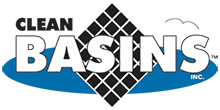Sewer Pipe Cleaning
 Our fleet of combination vacuum/flush trucks offers the largest and most modern units available anywhere. Bigger volumes in debris and water capacities allow us to complete line flushing jobs quicker than our competitors. Multiple attachments enable us to clean pipe sizes from 4 inches to 8 feet in diameter. We can also cut through debris, roots, and even calcified material.
Our fleet of combination vacuum/flush trucks offers the largest and most modern units available anywhere. Bigger volumes in debris and water capacities allow us to complete line flushing jobs quicker than our competitors. Multiple attachments enable us to clean pipe sizes from 4 inches to 8 feet in diameter. We can also cut through debris, roots, and even calcified material.
There are many types of conditions that require special types of cleaning. Clean Basins stands alone on the forefront of the pipe cleaning industry, due to the vast amount of equipment and knowledge necessary to complete any project. Cleaning is accomplished in many ways:
- Light Cleaning: The Sewer Jet is capable of removing grease, sand, mud, sludge, rocks and debris etc., from the pipelines. Location is never a concern, as Clean Basins can utilize its easement machine and variety of sewer scooters for those hard to reach places. Our fleet of VAC-CON combination units facilitate light cleaning by their simultaneous jetting and vacuuming of debris.
- Heavy Cleaning: Extreme grease conditions, roots, etc. are rendered routine by this service. Our winch crews work with the power winch continuously, day after day. They are experts at their trade in every sense of the word. Our most recent addition to our heavy cleaning division is our 120 Gallons Per Minute (GPM) VAC-CON for larger diameter pipes.
Why Sewer Cleaning?
Common to municipalities around the world is the need to maintain a clean and sanitary environment suitable for humans to live. This responsibility includes providing a system for efficiently moving both wastewater (sewage) and storm water.
A wastewater collection system is typically a network of pipes, manholes, cleanouts, traps, siphons, lift stations and other required structures to collect all the wastewater from an area and transport it to an environmentally safe place such as an treatment plant or disposal system.
Sewer systems can be located above or underground, typically running parallel to streets, housing, commercial and residential structures. This series of pipes and culverts are engineered as gravity flow systems, built on a slight grade to assist material flow. Most sewers are designed to convey material at a velocity of 2 feet (61 cm) per second. When velocity falls below this rate, solids will settle out of the flow to the bottom of the pipe, reduce flow capacity, and eventually cause a stoppage. If the velocity is designed to flow greater than 10 feet (300 cm) per second, solids could separate from the flow during low usage. At high velocities splashing occurs when the water changes directions, releasing odors and accelerating corrosion of concrete structures.
Partial or complete interruption of the flow may result from an obstruction in a sewer. When a stoppage occurs, material will backup and eventually overflow the system up to the point of the blockage. Streets, homes, and businesses can be damaged from the debris. Human health is threatened with unsanitary conditions and the spread of germs and disease
The objectives of a Sewer Cleaning and Maintenance Program is to operate and maintain the wastewater collection system so it will function and strive toward the following:
- Minimize the number of stoppages per mile of sewer pipe
- Minimize the number of odor complaints
- Minimize the number of lift station failures
Maintain intended flow in the system Systems around the world vary in many details. Type of material for the pipe, shape, size and location all differ. Regardless of these variables these systems must be routinely cleaned to ensure safe, consistent movement of the material.

